
The Cort Adeler House is a historic property located at Strandgade 22 in the Christianshavn neighbourhood of Copenhagen, Denmark. It takes its name from Admiral Cort Adeler who lived there for the last seven years of his life in the 17th century.

The Krak House is a Neoclassical property overlooking the square Nytorv in the Old Town of in Copenhagen, Denmark. It takes its name from the publishing house Kraks Forlag which was based there for many years. The Danish Centre for Culture and Development, a self-governing institution under the Danish Ministry of Foreign Affairs, is based in the building.
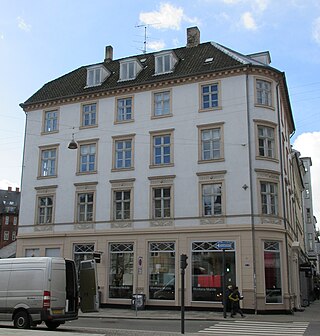
Bredgade 24 is a listed building located at the corner of Bredgade and Sankt Annæ Plads in central Copenhagen, Denmark. The building was listed on the Danish registry of protected buildings in 1987. Notable former residents include painter and photographer Niels Christian Hansen.

Badstuestræde 18 is a Neoclassical property in Badstuestræde in the Old Town of Copenhagen, Denmark, constructed for brewer Peter Møller as part of the rebuilding of the city following the Copenhagen Fire of 1795. It was listed in the Danish registry of protected buildings and places in 1918. Notable former residents include the philologist Jacob Baden, actor Peter Jørgen Frydendahl, ballet master Carl Dahlén, actress and opera singer Johanna Elisabeth Dahlén and later ballet master of the Royal Swedish Ballet, Sigurd Harald Lund.

Store Strandstræde 7 is a small building located close to Kongens Nytorv central Copenhagen, Denmark. The building was listed on the Danish registry of protected buildings and places in 1989.

Store Kannikestræde 8 is a historic building in the Old Town of Copenhagen, Denmark. It was listed on the Danish registry of protected buildings and places in 1945. It has been in use as the parish house of Trinitatis Parish since 1890. Notable former residents include the historian Rasmus Nyerupm illustrator Peter Christian Klæstrup and the architect and urban planner Conrad Seidelin.

The Obel House is a Neoclassical property located at Vestergade 2 in the Latin Quarter of Copenhagen, Denmark. It was listed on the Danish registry of protected buildings and places in 1918.

Vestergade 1 is a Neoclassical property located at the corner of Gammeltorv and the street Vestergade in the Old Town of Copenhagen, Denmark. The facade towards Gammeltorv and Vestergade meet in an Obtuse angle with four bays towards the square and five bays towards the street. The building was listed in the Danish registry of protected buildings and places in 1950. Café Gammel Torv, a traditional Danish lunch restaurant, has since 1910 been based in the basement at Gammeltorv 20. The building/restaurant is now colloquially known as The House With The Green Tree after an eponymous 1942 novel by Kalvin Lindemann.
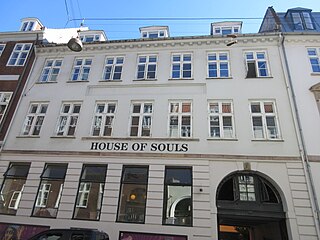
Vestergade 3 is a Neoclassical property in the Old Town of Copenhagen, Denmark. The building was constructed as part of the rebuilding of the city following the Copenhagen Fire of 1795. It was listed in the Danish registry of protected buildings and places in 1959. Notable former residents include the clergy Christian Bastholm and the painters Albert Küchler and Jørgen Roed.
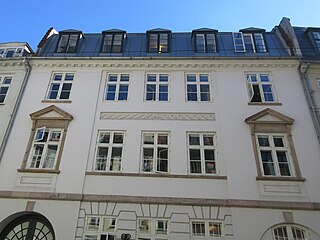
Vestergade 5 is a Neoclassical property in the Old Town of Copenhagen, Denmark. The building was constructed for the owner of the tobacco manufacturer Chr. Augustinus Fabrikker in 1797 and the company was until 1870 based in the complex. It was listed in the Danish registry of protected buildings and places in 1918.
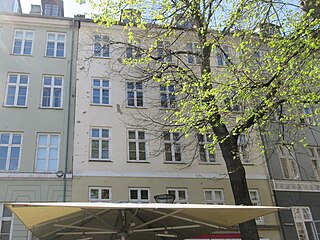
Gråbrødretorv 12 is a property situated on the west side of Gråbrødretorv in the Old Town of Copenhagen, Denmark. Like the other buildings on the west side of the square, the building was constructed after the British bombardment of Copenhagen in 1807. It was listed in the Danish registry of protected buildings and places in 1845. Former residents include pioneer of Swedish gymnastics Pehr Henrik Ling, civil servant and art collector Christian Frederik Holm and chief physician Rudolph Bergh.
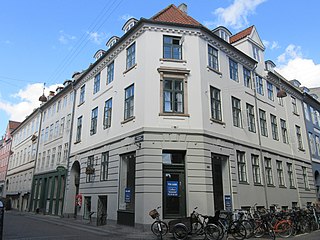
Kompagnistræde 10 is a Neoclassical property situated at the corner of Kompagnistræde and Badstuestræde in the Old Town of Copenhagen, Denmark. A bakery was operated on the site from at least the 17th century until the late 19th century. Like many of the other buildings in the area, the current building was constructed as part of the rebuilding of the city following the Copenhagen Fire of 1795. A gilded relief of a kringle above a door in the courtyard bears testament to the former use of the property. The entire complex was listed in the Danish registry of protected buildings and places in 1949. Former residents include orientalist Carl Theodor Johannsen and composer Christian Julius Hansen.
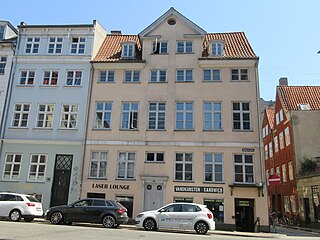
Rådhusstræde 17 is a Neoclassical property situated at the corner of Rådhusstræde and Magstræde, opposite Vandkunsten, in the Old Town of Copenhagen, Denmark. Dating from approximately 1800, it is one of the oldest buildings in the area. It was listed in the Danish registry of protected buildings and places in 1945.

Rådhusstræde 9 is an 18th-century property situated at the corner of Rådhusstræde and Kompagnistræde in the Old Town of Copenhagen, Denmark. The building was listed in the Danish registry of protected buildings and places in 1945. Former residents include the chemist Peter Ascanius and the marine painter Christian Eckardt. Galatheakroen, a bar decorated with exotica brought home from the 2nd Galathea Expedition, was opened in the ground floor by a former expedition member in 1958.
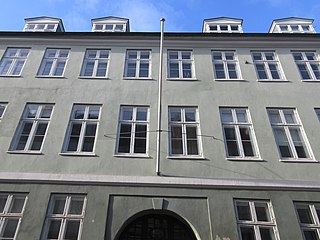
Brolæggerstræde 6 is a Neoclassical property situated in the Old Town of Copenhagen, Denmark. It was listed in the Danish registry of protected buildings and places in 1950. Former residents include the later bishop Jacob Peter Mynster and the politician Balthazar Christensen.

Brolæggerstræde 4 is a Neoclassical property situated in the Old Town of Copenhagen, Denmark. Like most of the other buildings in the area, it was constructed as part of the rebuilding of the city following the Copenhagen Fire of 1795. The three-winged complex was listed in the Danish registry of protected buildings and places in 1950.

Toldbodgade 5 is a 17th-century property situated in Toldbodgade, off Nyhavn in central Copenhagen, Denmark. It was listed in the Danish registry of protected buildings and places in 1977. The composer Carl Nielsen and the sculptor Anne Marie Carl-Nielsen resided in the apartment on the first floor from 1898 to 1906.

Rådhusstræde 10 is a complex of 18th and 19th-century buildings situated at the corner of Rådhusstræde and Vandkunsten in the Old Town of Copenhagen, Denmark. It consists of a two-storey corner building from 1750, a three-storey building in Rådhusstræde from 1851 and a rear wing from 1835. The entire complex was listed in the Danish registry of protected buildings and places in 1945.

Kompagnistræde 24 is a Neoclassical property situated on Strædet, between Knabrostræde and R¨dhusstræde, in the Old Town of Copenhagen, Denmark. It was constructed as part of the rebuilding of the city following the Copenhagen Fire of 1795 and later heightened with one storey in 1849. The building was listed in the Danish registry of protected buildings and places in 1979. Notable former residents include the artist Janus Laurentius Ridter.

Rådhusstræde 7 is a Neoclassical building situated at the corner of Rådhusstræde and Kompagnistræde in the Old Town of Copenhagen, Denmark. The building was like most of the other buildings in the street constructed as part of the rebuilding of the city following the Copenhagen Fire of 1795. It was listed in the Danish registry of protected buildings and places in 1918. The scope of the heritage listing was expanded in 1979. Notable former residents include the civil servant and naturalist Carl Gottlob Rafn and professor of philosophy Frederik Christian Sibbern.






















